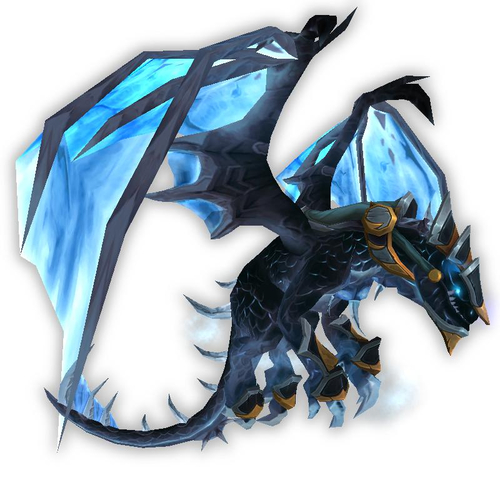Time dragon? I'm curious about this - what's a time dragon?
Well, in default D&D (well, Pathfinder) stuff, a "time dragon" looks like this.
They're basically cookie-cutter Gallifreyan-type "guardians of time" creatures who are supposed to be incredibly alien and only intervene in extreme circumstances. I find
this time dragon quite boring, both in appearance (it's basically a gold dragon with purple body scales and orange belly scales) and in behavior.
Instead, I went with something vaguely like a Red dragon in physical appearance, but colored like one of the Infinite Dragonflight dragons from WoW (essentially: "time bandit" dragons trying to change history in ways that would avert tragedies but would
cause much, much worse things instead.) For reference, this is what an Infinite Dragonflight dragon looks like (in this case, this is a mount from WoW):
I personally think this color scheme looks both enormously cooler and significantly more alien than "purple and orange." Further, all of my players are former WoW players, so they would instantly have an idea of what this dragon would look like.
Dragons in my
Jewel of the Desert game are classified as "Guardians," a type of being that is sort of halfway between being a proper outsider (celestials, fiends, aberrations, abominations) and a proper mortal (essentially all sapient races.) Guardians are
created, rather than born, gifted with power and a mission to fulfill via using that power. The only dragons known to exist in the PCs' world live on a different continent, Yuxia; guardians in the local area, the Tarrakhuna, appear to have been the Genie-Rajahs (who abused their powers rather badly and eventually forsook their mantle entirely, but tried to hold onto the power) and the El'Adrin (who pulled their entire civilization into a magical pocket-plane to prevent its destruction in a still-mysterious cataclysm long ago.)
This time dragon, who gave his name as Oleander Pierpont Mortcombe (did I mention he was excessively British?), appears to be a Guardian with a non-planetbound purpose, tending to the clockwork machinery of the universe and fixing up problems as they arise. He had been just casually observing when a Major Something happened that fractured spacetime on the PCs' world, and it caught him off-guard; he then realized, only too late, that this world had a metaphysical barrier around it which would allow things to
enter but would not allow them to
leave, meaning he was metaphysically "stuck" halfway manifested on their world. Coordinating themselves and using both physical and metaphysical strength and senses, the party was able to pull Oleander through the barrier to properly exist inside their world. He thanked them, promised to be of aid to them at a future date, and then vanished backward through time, intending to leave the planet before the barrier was erected in the first place.
It was something of a one-off encounter I dreamed up as part of the timey-wimey shenanigans of their most recent major adventure. Now, however, it gives me an excellent tool in the toolbox, because they've done Oleander a significant service. The aid of someone who can provide that aid
before you need it is an incredibly useful tool to have, but since he's clearly got his own job to do and can't just hare off to do whatever the players like whenever they like, and they have no means of contacting him directly, it manages to provide the justification for a rare-use
deus ex machina (or perhaps
deus ex dracone? Hah!) My players don't
strictly know this, other than knowing that they have earned a favor from a time dragon, but it's plausible they could figure it out or ask the right kinds of questions to learn it.
And that lays out my problem with that type of design very neatly: the same monster in the fiction doesn't have consistent mechanics; instead those mechanics are expected to vary vary depending solely on what it is fighting. Internal setting consistency? What's that?
Why does the mechanical representation need to be a direct, 1:1 correspondence with the fictional reality underneath? It's not like players are staring at these statblocks. They only see the qualitative, not the quantitative. If the quantitative is structured so that it produces the desired gameplay experience, what more does one need?
A creature's mechanics - its hit points, hit dice, fighting capabilities, etc. - should and must go with and remain tied to that creature throughout
I'm going to stop you there and reiterate the previous question. Why? What value is gained from this? The players don't see the numbers. They see the fantasy. Fantasy is comprised of two things. First, the narrative: the meaning, story, and
substance of the creature, aka "why does this matter
to us?" Second, the ecology: the environment, ambience, and interconnections.
Neither of these things are mechanics. They are, in fact,
completely disconnected from mechanics. So I am
deeply confused when you refer to them as "mechanics" in literally any way whatsoever. There is nothing mechanical about any of this.
Mechanics are the numbers, the statistics, the conditions and how they interact with one another. They are things which can be enumerated, as opposed to things which only admit qualitative description.


